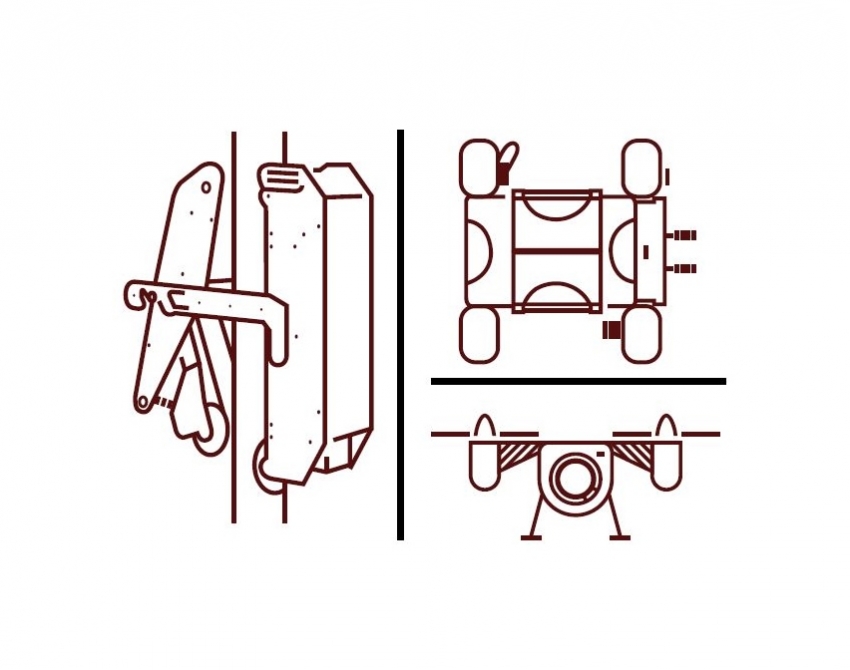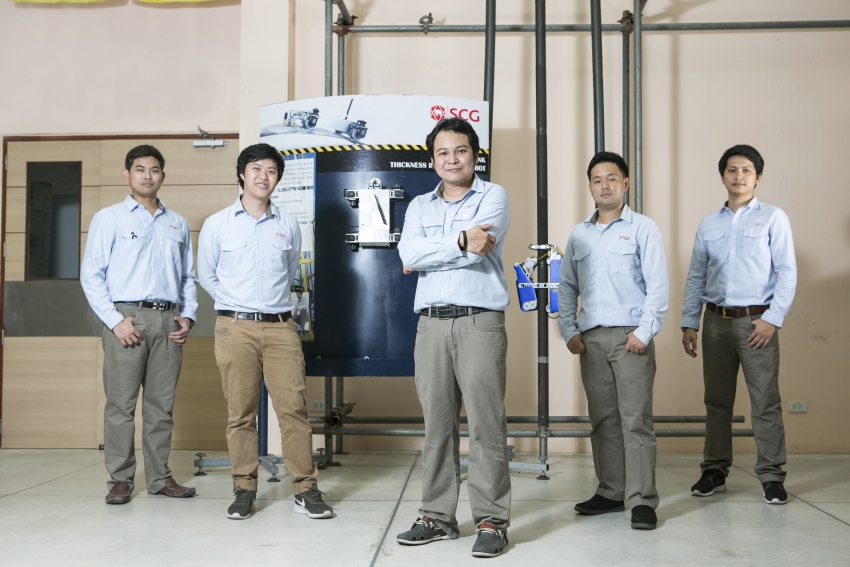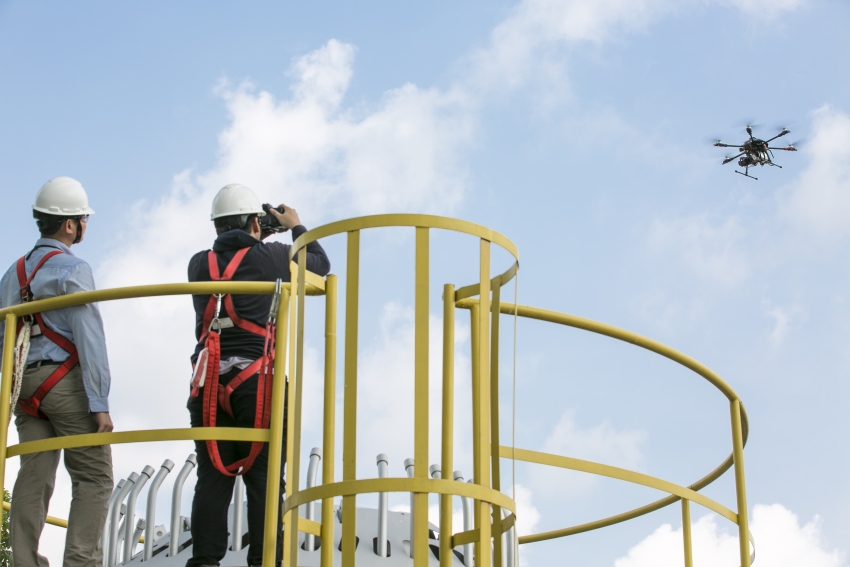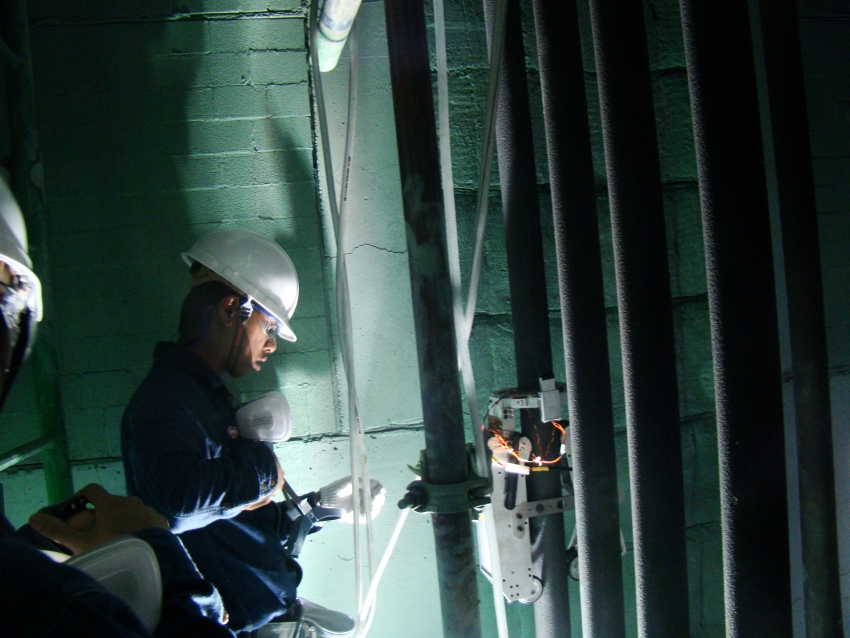CLICK HERE TO WATCH VIDEO
Our world has progressed to the era of Industry 4.0. As a robot inventor, I envision a future where robots will be ubiquitous and capable of working for humans. Equipped with both automatic and robotic systems, these intelligent helpers will be able to carry out tasks with incredible accuracy and precision and handle high-risk operations to increase efficiency and free up our time for other pursuits.
At Rayong Engineering & Plant Service Co., Ltd., a subsidiary of SCG Chemicals, we have included robots in the fabric of our operation for quite some time, but the most astonishing part is that my teammates and I are working together to develop our very own robots for equipment inspection and maintenance.
I have to admit that initially I wondered why we couldn’t simply import robots so we wouldn’t have to waste time building our own. However, once we started the robot development, I began to understand that the initiative showed great foresight. While importing technology seems like the easiest path, it means long-term dependence on foreign technology. If we choose to minimize this reliance and develop our own innovations, we will be able to better create sustainability in our organizations and country.
Then, why did we decide to build robots? It all began with our efforts to solve issues in our plant. We were concerned about technicians tasked with carrying out inspection or maintenance operations in certain parts of the plant as the environment in such areas could present serious threats to their safety. Sometimes, they needed to work on scaffolds, which, in addition to how time-consuming the assembly could be, posed work-at-height -related risks to the safety of technicians. Therefore, inventing robots seemed to be our best solution to improve work safety as well as enhance the management of the entire plant. Robots would help save time and production costs, minimize loss, and benefit communities and the environments.
At that time, I was given the opportunity to create robots to work in hazardous environments for humans. I have to say that I was thrilled with the prospect. It was a huge deal for an ordinary inventor like me to get to create my own technological invention. This was when I learned that building a robot was not beyond my capacity. I started out with an analysis to identify the root of the problem and determine a clear goal. Eventually, in 2009, our and the world’s first furnace coil inspection robot, also known as the Carburization Inspection Robot or CiBot* for short, was invented for use in olefins plants.
CiBot is employed to measure levels of carbon that has penetrated into the material of the coil inside furnaces in an olefins plant, causing the coil to become brittle, spring a leak, or break. Stringent and accurate regular inspections can help predict the lifespan of such coils and preemptively prevent damage from occurring. However, gauging the carbon level inside a furnace, in which the temperature can reach 1,200 degrees Celsius, could entail a series of steps if this task were to be carried out by human technicians. The furnace would have to be shut down and cooled down completely, and scaffolding would have to be constructed for technicians to climb before they could, from over ten meters above the ground, take measurements of the carbon levels. Afterwards, the scaffolds would need to be disassembled before the furnace could be started up. The entire process may take up to 3-4 days, and it is commonly known that downtime lasting several days means a sizable loss of income.
CiBot enables us to assess the life expectancy of the coil and thoroughly inspect it with seven times greater precision and speed. These advantages aside, the innovation also serves its purpose as solution for safety as it can replace humans and protect them from potential risks from operating in high places in confined space.
The success of CiBot inspired us to develop its subsequent cousins. Our team began to discover the fun in building robots in order to solve a greater range of issues. As shown earlier, achieving robots that fully answer the usage need begins with understanding the problem and identifying a clear goal to tackle.
Once we achieved CiBot, we moved on to a robot that could reduce the risk of working at height. That robot was an Aerial Visual Inspection Robot, which could be flown over a plant to inspect its machinery and equipment, especially flare stacks, which are usually as tall as a 40-story building. In the past, humans had to scale the flare stacks to perform that task themselves, which could be carried out only during a major plant turnaround every 5-6 years - the only time that human technicians would not have to face the staggering 1,300 degrees Celsius at the tips of the flare stacks. However, the Aerial Visual Inspection Robot is ideal for such inspection tasks as it has been designed specifically to operate in petrochemical plants. Its autopilot mode, for instance, makes it possible to map flight routes in advance to avoid risky zones as well as change flight coordinates mid-flight. With such capabilities, the robot has obviated the need to impose an outage, which in turn helps save tremendous time and costs.
Another robot that packs just as much punch is the Tank Inspection Robot, which can measure the thickness of tanks used in petrochemical industry in order to ensure that their safety is in accordance with regulations and universal standards. Equipped with the capacity to climb up and down tank walls and can measure the thickness of both cylindrical and spherical tanks, this robot has obviated the need to put human technicians on scaffolding to risk themselves and perform the inspection.
Nowadays, my team still continues to innovate and create robots to assist in our industrial operations. We have successfully built robots that solve issues specific to petrochemical plants and have turned into true experts in this area. It is incredible to look back on the period of over a decade in which we went through trial and error and performed numerous tests in our own plant. Through the process, we have gained insight and have been able to expand the scope of our work beyond our organizations and eventually provide inspection services for plants and other infrastructure for maintenance. For these services, we use our robots to carry out the inspection in tandem with technical evaluation from our experts and successfully achieve the harmonious combination of robotic and automatic systems. Today, we have been trusted by clients both in Thailand and from overseas such as Singapore, South Korea, and other European countries. This wide recognition is truly a testament to the quality of the robots invented by Thai people, which are on par with international standards.
As industries are growing exponentially and changing more rapidly than ever, robotics might be an answer for the industrial sector in attaining sustainable growth. Having worked in robot development for many years, I anticipate further development of robots in the industrial sector. It is my conviction that robots will help us achieve greater efficiency in our operation by replacing humans in operations that involve safety risks or areas that are difficult to inspect. However, how beneficial they can be, of course, will depend on their user and his or her ability to analyze, synthesize, and process information. After all, robots themselves cannot perform all tasks; it is humans that have boundless capacity to do just everything.
The development timeline of SCG Chemicals’ robots
2009 Research and development of its first robot CiBot (Carburization Inspection Robot)
2013 Performance enhancement of CiBot (Carburization Inspection Robot) and the first phase of the development of the Tank Inspection Robot
2014 Development of the Tank Inspection Robot
2015 Development of the Aerial Visual Inspection Robot
2016 Performance enhancement of the Tank Inspection Robot and CiBot (Carburization Inspection Robot)
Remark
*Carburization Inspection Robot or CiBot Patent Pending Application No. PCT-TH2017-000001








